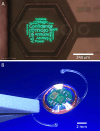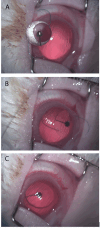In Vivo Stability of Electronic Intraocular Lens Implant for Corneal Blindness
- PMID: 40569125
- PMCID: PMC12205567
- DOI: 10.1167/tvst.14.6.33
In Vivo Stability of Electronic Intraocular Lens Implant for Corneal Blindness
Abstract
Purpose: Electronic technology can add new function to intraocular lenses, including the treatment of corneal blindness. However, it is not known if such an implant can be stably implanted within a living eye over time. This study investigates the long-term stability and safety of an intraocular lens-shaped implant with an embedded electronic microdisplay for potential use in treating corneal blindness.
Methods: Five intraocular implants containing a nonfunctional microdisplay and projection optic were surgically implanted into five rabbits after removal of their crystalline lenses. This blocks the natural pathway of light into the eye. The rabbits were monitored over 6 months with photography and biometry to assess the centration and axial stability of the implants.
Results: All implants were successfully implanted and remained stable over the 6-month trial. The average distance from the cornea center was 0.868 ± 0.442 mm at 1 month and 0.851 ± 0.591 mm at 6 months. Anterior chamber depth, representing axial stability, was 4.362 ± 0.213 mm at 1 month and 4.351 ± 0.218 mm at 6 months. While posterior capsular opacification and iris adhesions were observed, no major complications occurred.
Conclusions: This study is the first to demonstrate long-term stability of an intraocular lens-shaped implant containing an electronic display and optical system. These findings suggest that such implants are viable and safe, supporting their potential as a treatment for corneal blindness and other broader applications.
Translational relevance: Evidence of safety and stability of electronic intraocular lenses in animals paves the way for the study of this emerging field of medical implants in humans.
Conflict of interest statement
Disclosure:
Figures





Similar articles
-
Intraocular lens optic edge design for the prevention of posterior capsule opacification after cataract surgery.Cochrane Database Syst Rev. 2021 Aug 16;8(8):CD012516. doi: 10.1002/14651858.CD012516.pub2. Cochrane Database Syst Rev. 2021. PMID: 34398965 Free PMC article.
-
Capsular Tension Ring Implantation for Intraocular Lens Decentration and Tilt in Highly Myopic Eyes: A Randomized Clinical Trial.JAMA Ophthalmol. 2024 Aug 1;142(8):708-715. doi: 10.1001/jamaophthalmol.2024.2215. JAMA Ophthalmol. 2024. PMID: 38935400 Free PMC article. Clinical Trial.
-
Blue-light filtering intraocular lenses (IOLs) for protecting macular health.Cochrane Database Syst Rev. 2018 May 22;5(5):CD011977. doi: 10.1002/14651858.CD011977.pub2. Cochrane Database Syst Rev. 2018. PMID: 29786830 Free PMC article.
-
Manual small incision cataract surgery (MSICS) with posterior chamber intraocular lens versus extracapsular cataract extraction (ECCE) with posterior chamber intraocular lens for age-related cataract.Cochrane Database Syst Rev. 2012 Apr 18;(4):CD008811. doi: 10.1002/14651858.CD008811.pub2. Cochrane Database Syst Rev. 2012. Update in: Cochrane Database Syst Rev. 2014 Nov 18;(11):CD008811. doi: 10.1002/14651858.CD008811.pub3. PMID: 22513967 Updated.
-
Trifocal intraocular lenses versus bifocal intraocular lenses after cataract extraction among participants with presbyopia.Cochrane Database Syst Rev. 2023 Jan 27;1(1):CD012648. doi: 10.1002/14651858.CD012648.pub3. Cochrane Database Syst Rev. 2023. PMID: 36705482 Free PMC article.
References
-
- Gain P, Jullienne R, He Z, et al.. Global survey of corneal transplantation and eye banking. JAMA Ophthalmol. 2016; 134(2): 167–173. - PubMed
-
- Islam SS, Doyle EJ, Velilla A, Martin CJ, Ducatman AM.. Epidemiology of compensable work-related ocular injuries and illnesses: incidence and risk factors. J Occup Environ Med. 2000; 42(6): 575–581. - PubMed
-
- Kohanim S, Palioura S, Saeed HN, et al.. Acute and chronic ophthalmic involvement in Stevens-Johnson syndrome/toxic epidermal necrolysis—a comprehensive review and guide to therapy. II. Ophthalmic disease. Ocul Surf. 2016; 14(2): 168–188. - PubMed
-
- EBAA. Eye banking statistical report. 2016, http://restoresight.org/wp-content/uploads/2017/04/2016_Statistical_Repo.... Accessed May 1, 2024.
MeSH terms
Grants and funding
LinkOut - more resources
Full Text Sources
Medical

